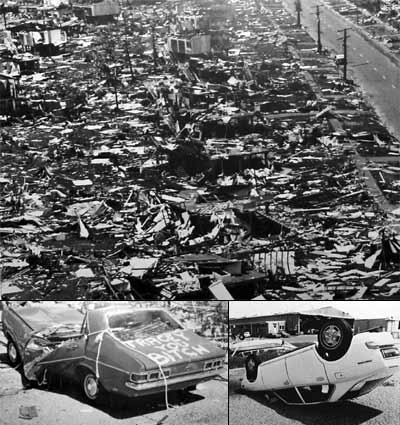In My Book, That’s a Hurricane
There were two things that drew me to Darwin: the heat and the cyclone. The
heat was easy to comprehend upon arrival, but I filled in what little I knew
about the cyclone with a visit to the Museum & Art Gallery of the Northern
Territory. In a fascinating display that included samples of home construction
and even a room with recordings from the storm, I learned the story:

In the early hours of Christmas 1974, Darwin became the site of the worst
natural disaster Australia has ever known. What first began as a weak tropical
lull some five days earlier began to pick up steam and was named Tracy by meterologists
on 21 December. Tracy was on track to hit Darwin with a vengeance: just after
noon on Christmas Eve, a "Flash Cyclone Warning" went out warning residents
that the storm would bring very destructive winds.
After midnight, Tracy landed with 100 km/h winds, gusting to 195 km/h.
(Three hours later, the anemometer was broken after recording a gust
of 217 km/h.) Later analysis suggested that winds reached 260 km/h, with others putting the figure as high as 320km/h. Winds in excess of 100 km/h continued until 7am.
Most of the city’s 48,000 people became homeless. Hardest hit was the suburb of Nakara, where 97% of homes were destroyed. Throughout the city, communication, power, and utility links were disrupted. Over the next several days, the Australian military took things in hand, patrolling for looters as an RAAF/USAF joint
airlift took nearly 26,000 people out of the city. A further 10,000 left by
road.
When all was said and done, the death toll officially stood at 49, with a
further 16 "missing at sea." (Unofficial estimates were much higher.) The damage
was tallied at between A$500 million – A$1 billion in 1974 dollars.
The greatest contributor to the damage was the construction style common for
the time. An open-air design featuring glass louvers and elevated homes was
well suited for the tropical temperature, but lethal when the debris began
flying about. A federally-established Darwin Reconstruction Commission set
new standards — informally called "the Cyclone Code" — that were
designed to ensure Darwin was never again destroyed. The regulations demanded that new houses contain their own cyclone shelters and be able to withstand winds of 65 m/s (234 km/h.) This has since been relaxed to 55 m/s due to the expenses involved.
And it’s not the first time that widespread reconstruction was taking place:
Darwin was also destroyed in 1942 by the Japanese.
